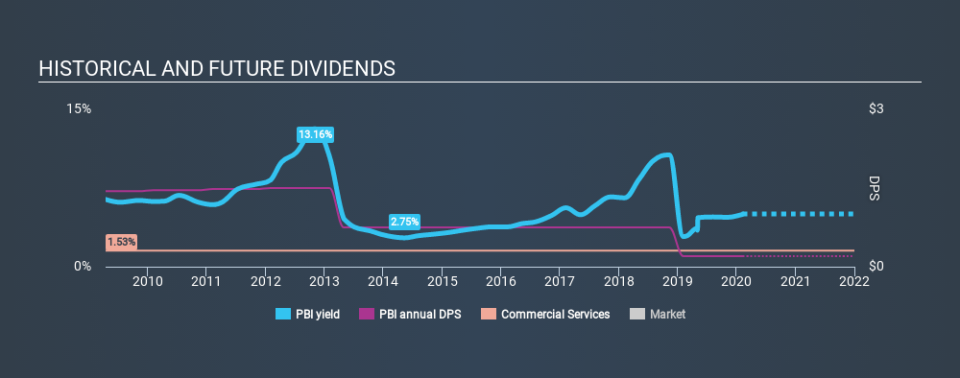Why It Might Not Make Sense To Buy Pitney Bowes Inc. (NYSE:PBI) For Its Upcoming Dividend

Pitney Bowes Inc. (NYSE:PBI) stock is about to trade ex-dividend in 4 days time. Ex-dividend means that investors that purchase the stock on or after the 13th of February will not receive this dividend, which will be paid on the 9th of March.
Pitney Bowes's upcoming dividend is US$0.05 a share, following on from the last 12 months, when the company distributed a total of US$0.20 per share to shareholders. Based on the last year's worth of payments, Pitney Bowes has a trailing yield of 5.0% on the current stock price of $3.98. Dividends are an important source of income to many shareholders, but the health of the business is crucial to maintaining those dividends. We need to see whether the dividend is covered by earnings and if it's growing.
See our latest analysis for Pitney Bowes
Dividends are typically paid from company earnings. If a company pays more in dividends than it earned in profit, then the dividend could be unsustainable. It paid out 88% of its earnings as dividends last year, which is not unreasonable, but limits reinvestment in the business and leaves the dividend vulnerable to a business downturn. It could become a concern if earnings started to decline.
Click here to see the company's payout ratio, plus analyst estimates of its future dividends.
Have Earnings And Dividends Been Growing?
Businesses with shrinking earnings are tricky from a dividend perspective. If earnings decline and the company is forced to cut its dividend, investors could watch the value of their investment go up in smoke. Pitney Bowes's earnings per share have plummeted approximately 31% a year over the previous five years.
Another key way to measure a company's dividend prospects is by measuring its historical rate of dividend growth. Pitney Bowes has seen its dividend decline 18% per annum on average over the past ten years, which is not great to see. It's never nice to see earnings and dividends falling, but at least management has cut the dividend rather than potentially risk the company's health in an attempt to maintain it.
Final Takeaway
Is Pitney Bowes an attractive dividend stock, or better left on the shelf? We're not overly enthused to see Pitney Bowes's earnings in retreat at the same time as the company is paying out more than half of its earnings as dividends to shareholders. We think there are likely better opportunities out there.
Wondering what the future holds for Pitney Bowes? See what the four analysts we track are forecasting, with this visualisation of its historical and future estimated earnings and cash flow
If you're in the market for dividend stocks, we recommend checking our list of top dividend stocks with a greater than 2% yield and an upcoming dividend.
If you spot an error that warrants correction, please contact the editor at editorial-team@simplywallst.com. This article by Simply Wall St is general in nature. It does not constitute a recommendation to buy or sell any stock, and does not take account of your objectives, or your financial situation. Simply Wall St has no position in the stocks mentioned.
We aim to bring you long-term focused research analysis driven by fundamental data. Note that our analysis may not factor in the latest price-sensitive company announcements or qualitative material. Thank you for reading.

